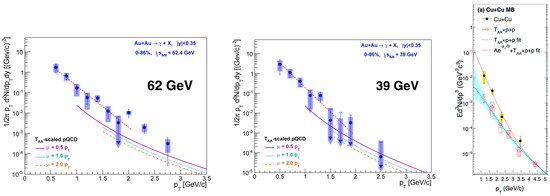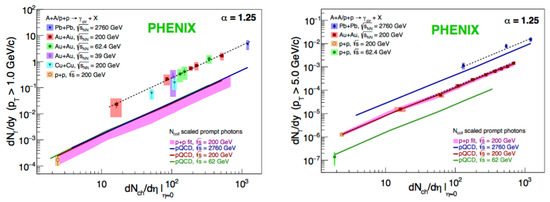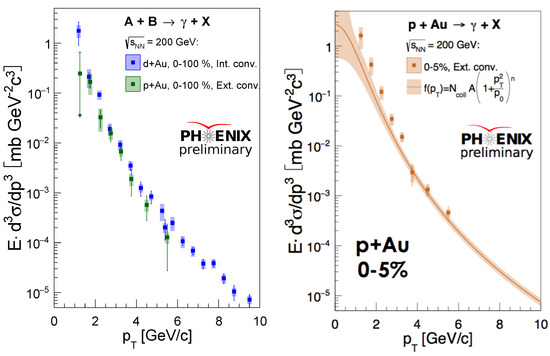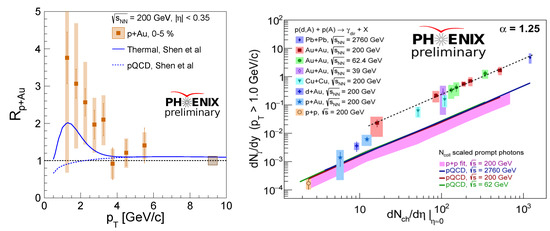Abstract
Direct photons are a unique probe to study the properties of the medium created in heavy ion collisions. Low transverse momentum () direct photons are of special interest since thermal photons are supposed to be dominant, while at high direct photons come from initial hard scattering (pQCD). PHENIX has observed a large excess of direct photon yield as well as large azimuthal anisotropy at low in Au+Au collisions at the c.m.s energy per nucleon pair GeV. The mechanism to produce a large direct photon yield with a large elliptic anisotropy () is not well understood yet. PHENIX has made systematic measurements of direct photons with different collision energies and system configurations. It has been found that direct photon yield is proportional to charge particle multiplicity . This behavior holds for beam energies measured both at RHIC and at the LHC in large systems. This scaling suggests that there is a transition from p+p to A+A system which could be understood with the analysis of smaller systems like p+Au and d+Au.
1. Introduction
Due to the fact that photons do not interact strongly in heavy ion collisions, they can carry primordial information about the collision at the time of their production, namely temperature evolution and collective motion of the matter. Photons are very abundant in heavy ion collisions, however, most of them come from hadronic decays, mainly and to . The so called direct photons are those which do not come from hadronic decays; they can be determined experimentally by subtracting from the total yield the expected fraction coming from hadron decays. In large systems and at low , it is expected that the dominant source of direct photons is emission from the QGP and from the hadronic gas phase; whereas at high , their origin is connected to initial state interactions produced in the hard scattering.
2. Challenges
The PHENIX experiment measured not only the direct photon yield but also its azimuthal anisotropy in Au+Au collisions at GeV. A large yield and a large were found, which is challenging to theoretical models because a large yield implies early emission when the temperature is higher, but a large implies late emission when the flow is fully developed. Details can be found in [1]. In order to understand this observation, PHENIX has performed similar measurements on different datasets. In large systems, PHENIX has measured: Au+Au collisions at GeV and Cu+Cu at GeV. In small systems, PHENIX has measured: p+p, p+Au, d+Au (MB) at GeV. We will discuss these measurements in the next sections.
3. Large Systems
3.1. Yield
The measurement of direct photon yield in Au+Au collisions at GeV is well established [2]. The yield follows the p+p signal scaled to the number of binary collision () above 4 GeV/c in , but there is a significant excess of the direct photon yield at below 3 GeV/c. The excess has a nearly exponential shape. Recently, the direct photon yield at low was measured in Au+Au collisions at 62.4 GeV and 39 GeV via the external conversion method [3]. A clear direct photon signal excess was found at low compared to the pQCD prediction scaled by the . The results can be seen in Figure 1. Cu+Cu collisions at 200 GeV were also explored [4] via the internal conversion method. The direct photon yield for Cu+Cu minimum bias (MB) can be seen in the right panel of Figure 1. It shows that the Cu+Cu signal has a clear direct photon yield excess over the binary-scaled p+p baseline. Similar behavior is expected in other large systems, and it was recently reported in Pb+Pb 2760 GeV by the ALICE experiment [5].

Figure 1.
Low direct photon yield for Au+Au collisions at GeV (left), Au+Au collisions at GeV (middle) and Cu+Cu collisions at GeV (right) [4].
3.2. Scaling
In order to compare the different collision systems and energies, and gain insight in the mechanism of the direct photon production, the yield was integrated. It can be represented as a function of the number of participants (), but has limitation because it saturates at the same value for similar system size at different beam energies. So instead of , the number of charged particles () was used. Figure 2 shows the integrated direct photon yield for GeV/c (left) and GeV/c (right) versus the number of charge particles, . In the plot there is data from Au+Au collisions at 200 GeV, 62 GeV, 39 GeV, Cu+Cu collisions at 200 GeV and Pb+Pb collisions at 2760 GeV from ALICE [5]. A universal scaling behavior of with is observed, independent of the system, energy or centrality for GeV/c. The p+p fit scaled by the number of collisions is significantly lower. This scaling behavior can indicate that the low direct photons are produced around the critical temperature when the transition from QGP to hadron gas happens. The integrated yield at hight , GeV/c, follows the p+p fit scaling by the number of collision for Au+Au data as expected, where the dominant photons are the ones that come from hard scattering.

Figure 2.
Integrated direct photon yield vs. for different collision systems and energies, integrated in GeV/c (left) and GeV/c (right). The plots are from [3].
4. Small Systems
PHENIX has recently measured low momentum direct photon production in p+Au collisions at 200 GeV. While the p+Au MB direct photon signal is consistent with p+p scale, the most central p+Au show a hint of excess over the binary-scaled baseline, as seen in Figure 3. A previous measurement in small systems, d+Au [6] did not show a significant modification of the direct photon distribution. These last data are consistent with the results from MB in p+Au collisions, Figure 3 left. Figure 4 left shows the ratio of the direct photon yield in p+Au to p+p scaled by the number of binary collisions as a funtion of . The ratio shows a hint for a significant excess, which is compatible with theoretical calculations of thermal emission [7].

Figure 3.
Direct photon yield at low in d+Au and p+Au MB (left), and p+Au central collision at 200 GeV (right).

Figure 4.
vs for p+Au collisions at GeV at 0–5 % centrality (left). Direct photon yield integrated above 1 GeV/c vs , compared with the large system data from small systems (right).
5. Conclusions
In order to understand better the low direct photon signal, PHENIX has performed the measurement at different energies and systems: Au+Au collisions at 39 and 62.4 GeV, Cu+Cu collisions at 200 GeV. A unique scaling behavior of the integrated direct photon yield with respect to the was observed with collision energies and different systems and centralities. This scaling may be an indication that direct photons are produced during the transition from QGP to the hadron gas. The hint of an excess in p+Au can indicate a possible formation of QGP droplets in the small systems. The data suggest the transition between p+p to A+A like yields in a narrow multiplicity range.
References
- Adare, A.; Afanasiev, S.; Aidala, C.; Ajitanand, N.N.; Akiba, Y.; Akimoto, R.; Al-Bataineh, H.; Alexander, J.; Alfred, M.; et al. (PHENIX Collaboration) Azimuthally anisotropic emission of low-momentum direct photons in Au + Au collisions at GeV. Phys. Rev. C 2016, 94, 064901. [Google Scholar] [CrossRef]
- Adare, A.; Afanasiev, S.; Aidala, C.; Ajitanand, N.N.; Akiba, Y.; Akimoto, R.; Al-Bataineh, H.; Alexander, J.; Alfred, M.; et al. (PHENIX Collaboration) Centrality dependence of low-momentum direct-photon production in Au + Au collisions at GeV. Phys. Rev. C 2015, 91, 064904. [Google Scholar] [CrossRef]
- Adare, A.; Afanasiev, S.; Aidala, C.; Ajitanand, N.N.; Akiba, Y.; Akimoto, R.; Al-Bataineh, H.; Alexander, J.; Alfred, M.; et al. (PHENIX Collaboration) Beam-energy and centrality dependence of direct-photon emission from ultra-relativistic heavy-ion collisions. arXiv 2018, arXiv:1805.04084. [Google Scholar]
- Adare, A.; Afanasiev, S.; Aidala, C.; Ajitanand, N.N.; Akiba, Y.; Akimoto, R.; Al-Bataineh, H.; Alexander, J.; Alfred, M.; et al. (PHENIX Collaboration) Low-momentum direct photon measurement in Cu+Cu collisions at GeV. arXiv 2018, arXiv:1805.04066. [Google Scholar]
- Adam, J.; Adamová, D.; Aggarwal, M.M.; Rinella, G.A.; Agnello, M.; Agrawal, N.; Ahammed, Z.; Ahn, S.U.; Aiola, S.; Akindinov, A. (ALICE Collaboration) Direct photon production in Pb-Pb collisions at TeV. Phys. Lett. B 2016, 754, 235. [Google Scholar] [CrossRef]
- Adare, A.; Afanasiev, S.; Aidala, C.; Ajitanand, N.N.; Akiba, Y.; Akimoto, R.; Al-Bataineh, H.; Alexander, J.; Alfred, M.; et al. (PHENIX Collaboration) Direct photon production in d+Au collisions at GeV. Phys. Rev. C 2013, 87, 054907. [Google Scholar] [CrossRef]
- Shen, C.; Paquet, J.-F.; Denicol, G.S.; Jeon, S.; Gale, C. Collectivity and electromagnetic radiation in small systems. Phys. Rev. C 2017, 95, 014906. [Google Scholar] [CrossRef]
Publisher’s Note: MDPI stays neutral with regard to jurisdictional claims in published maps and institutional affiliations. |
© 2019 by the author. Licensee MDPI, Basel, Switzerland. This article is an open access article distributed under the terms and conditions of the Creative Commons Attribution (CC BY) license (https://creativecommons.org/licenses/by/4.0/).